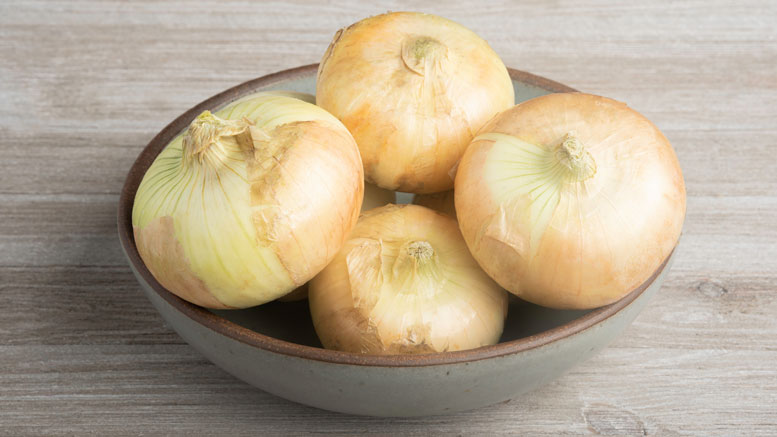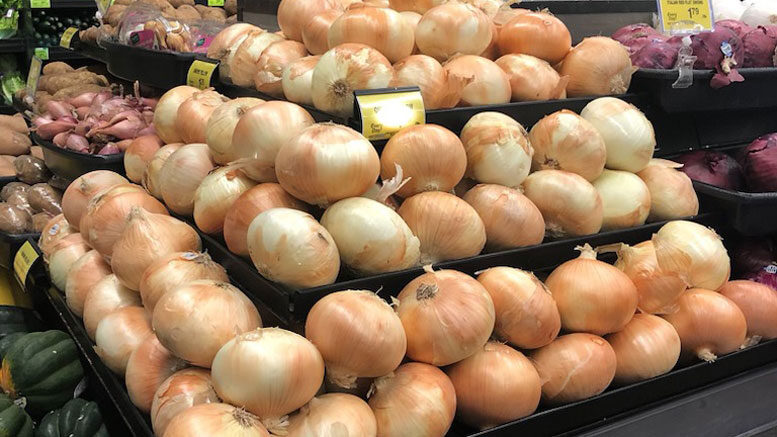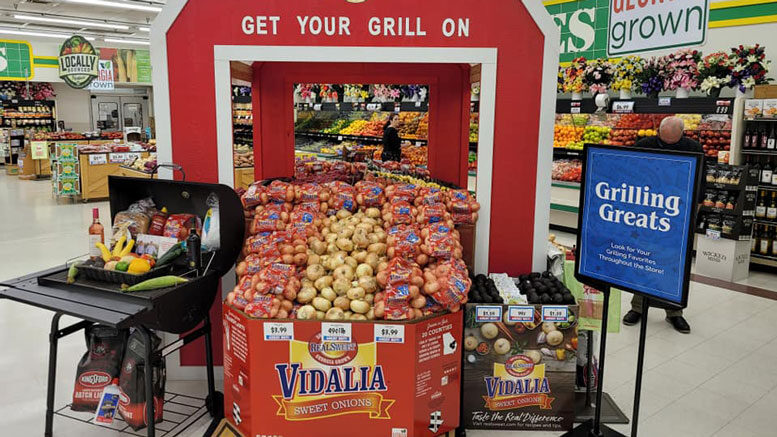Gear Up For Sweet Success
April 25, 2023 | 9 min to read
As summer approaches, Americans eagerly await the arrival of sweet onions, which are favored for their versatility in salads, sandwiches, and grilling. With the season starting in March and lasting through July, varieties like Vidalias and Walla Wallas dominate consumer demand. Retailers are encouraged to promote these onions through dynamic displays and cross-merchandising to boost sales, especially amidst ongoing inflation. Enhanced offerings, including organic options, cater to a growing consumer preference for high-quality, sustainable produce.

PRODUCE BUSINESS/MIKE DUFF PHOTO
Americans Can’t Wait For Sweet Onions to Hit the Stores.
Originally printed in the April 2023 issue of Produce Business.
Americans are gearing up for summer, and that means salads, sandwiches, grilling and a huge, at-home meal mainstay — sweet onions.
Sweet onions continue to be popular with chefs and home cooks, thanks to, well, their sweetness, whether raw in salads or sandwiches, marinated or lightly cooked. Popular mild, fresh sweet onions include Vidalias, Walla Wallas, the Texas Sweets, Mauis and the Pennsylvania Simply Sweet Onion, among others. The category is definitely growing for retailers, and consumers expect to see sweet onions in the store.
According to the Eaton, CO-based National Onion Association (NOA), the season starts in March with the sweets out of Texas, followed by the Vidalias out of Georgia, then the Walla Walla sweets in Washington in June. Other varieties and growing regions add to the U.S. sweet onion season, and Peruvian and Mexican sweets are also entering the market, so the supply is almost year-round.
But shoppers still think of sweet onions as a harbinger of spring and summer, says Derrell Kelso, manager at Stockton, CA-based JJB Family Farms, which is a grower, but also a huge buyer, packer and distributor of onions, supplying at least 2,000 West Coast stores.
Consumers just start cooking differently in the spring, like barbecuing, Kelso says. “Sweet onions are one item that go very well with seasonal eating trends, and retailers need to see that. If they don’t, we point it out to them and suggest they broaden their sweet onion offering.”
Steven Shuman, general manager and vice president of sales at G&R Farms, Glennville, GA, agrees the time is right to spotlight sweet onions.
“Sweet onions are enjoyed year-round, thanks to the expansion of the Peruvian sweet onion program,” Shuman says, “but there is no doubt the domestic sweet onion season is when consumers really start to enjoy sweet onions, and we see strong consumer sales.”
For many consumers, the Vidalia is synonymous with “sweet onion,” but it refers only to the sweets grown in 20 south Georgia counties. The Vidalia sweet onion season starts around the third week of April and runs through August.
“Vidalia is the sweet onion consumers ask for by name,” Shuman declares.
PROMOTE THEM NOW
Inflationary pressures continue to impact consumers’ purchases, but sweet onion sales are expected to stay strong, as shoppers understand it’s often more affordable to eat at home. But as those shoppers try to stretch their dollars, consumers will be looking for more promotional activity. Retailers can use in-store merchandising, loyalty programs or social media/e-commerce messaging to boost sweet onion sales.
Kelso says retailers have an opportunity to promote sweet onions now, as the domestic season strengthens.
This year, April through June or July is going to be an opportunity for retailers to promote sweet onions, he adds. “We’ve had a lot of rain [California], so that means they’re going to size well, and the prices are going to be fairly stable. And so there’s going to be a lot of opportunity for retailers to make good purchases and really good promotions.”
In the third quarter, though, there could be some gaps, Kelso says, because of the weather, particularly the cold California experienced in the first quarter.
“The tough thing with the sweet onion category is price points are changing. You can’t look back at what you used to be able to sell them at five years ago and expect to do that,” Kelso says.
“Don’t be afraid to charge for them,” emphasizes Jeff Brechler, sales at Little Bear Produce, a south Texas-based grower-shipper that specializes in onions, among other produce, and has developed its own exclusive HoneySweet onions. “Sweet onions have fallen into the commodity trap, and they don’t need to be.”
“Consumers/shoppers want high-quality sweets year-round, and they have shown they are willing to pay a premium for a truly good, truly sweet onions,” says Teri Gibson, director of marketing and customer relations at Peri & Sons Farms, a Yerington, NV-based onion grower and shipper. With its Nevada and California acreage, the operation supplies onions year-round.

PHOTO COURTESY PERI & SONS
She says sweet onions now account for half of all onion sales and can command a higher ring at the register than other varieties. ”Retailers that offer true sweet onions have a lot of leeway for pricing and being creative with ads.”
GET A HANDLE ON THINGS
Fresh market sweet onions have a high water content, so produce department employees need to place onions into the display and not dump or drop them, which will bruise them. The Texas 1015 Sweet Onion program suggests stockers who are refilling displays give the onions a squeeze to check for firmness and remove any onions that feel slightly spongy or are starting to have dark spots. And fresh onions don’t like to be cold or wet, so keep them cool and dry, and keep the air circulating around your displays.
The NOA advises onions be placed tops up (root end down) in bulk displays and retail employees remove loose skins. Proper stock rotation ensures quality; placing newest onions on the bottom is key.
Depending on the variety, sweet onions are off-white to yellow in color. Most shippers offer a variety of pack and display options, from large display bins to consumer bags, and display-ready containers and cartons. If you’re displaying by the bag, arrange them no more than two to three bags deep on a table.
Signage is key, particularly as shoppers are looking for those sweet onions when the season gets underway. Remind consumers that sweet onions are fresh, and add signage that emphasizes “now in season.”
“Retailers should take every opportunity to highlight the seasonal changes in sweet onion varieties with bountiful displays, signage and special digital promotions at the beginning of each season,” advises Gibson.
That early-season hype is key, agrees G&R Farms’ Shuman. “It’s important to leverage merchandising and signage to take advantage of early season excitement.”
To kick off the sweet season, he recommends displaying Vidalia onions on endcaps for six weeks to build repeat purchases leading into the summer.
ESSENTIAL TEAM PLAYER
Bring sweet onions front and center if you want to sell more, says Little Bear Produce’s Brechler. “The onion is not a center-of-the-plate item. It’s not the quarterback of the team; it’s the lineman. It’s an unsung hero that doesn’t get the light shined on it, so it’s hard to take the onion from the complementary role to the center of the plate. But it’s an essential part of the team.”
One way retailers can distinguish the sweet onions from yellow onions is to display them prominently, advises Troy Bland, CEO of Bland Farms, Glennville, GA. “Create a sweet onion destination in the produce department. This would include bulk, bagged and organic offerings in a single area.”
Like other grower-shippers, Bland Farms makes merchandising easy for retailers. “We provide retailers with point-of-sale material and eye-catching secondary display bins that look great and attract customers,” explains Bland.
“Sweet onions move other items. It’s one of the top movers in the United States,” stresses JJB Family Farms’ Kelso. “And you can’t move a sweet onion unless you’re moving a meal. It’s not like a cherry, where people are going to grab it off the shelf and eat it. People cook with it, they make salads with it.”
That’s one of the reasons JJB spotlights graphics of sweet onions with avocados or tomatoes or other produce aisle items on its bag, he adds. “We call it ‘kitchen counter merchandising.’ We actually have a shopping list on the bag for all the ingredients, and that can increase incremental sales.”
“If they pick up that sweet onion, they’re going to pick up something else, too.”
Due to the versatility and mild flavor, sweet onions are the perfect item to pair with items throughout the produce department, such as peppers, tomatoes, bagged salads, potatoes, mushrooms and more, agrees John Shuman, president and chief executive of Shuman Farms, Reidsville, GA.

PHOTO COURTESY SHUMAN FARMS
“The quickest and easiest way to drive sales of sweet onions and increase overall produce department basket size is with cross-merchandising.”
“We recognize the value of cross-merchandising to retailers,” says Bland. “If we can help retailers make the shopping experience more convenient, they build trust and increase sales.”
In addition to its sweet onions, Bland Farms offers value-added products such as Vidalia Sweet Onion snacks or Sweet Onion Petals, and condiments such as its Vidalia Blossom Kit and Vidalia Peach Salsa, which let customers enjoy sweet onion snacks year-round.
The company provides turnkey seasonal programs individual retailers can run. “Whether they use them just as they come or build from what we provide, we make it easy for supermarket retailers to generate excitement around Vidalia onions,” Bland says.
G&R Farms’ Shuman recommends retailers allocate 25% to 35% of space planning to sweet onions.
KEEP ORGANIC OFFERINGS JUST AS SWEET
There’s been a steady increased demand for organic produce as a whole, and sweet onions are no different, says Bland Farms’ Bland.
“Consumers are becoming much more conscious of what they consume,” he explains, adding Bland Farms has increased its volume of organic onions production as the demand increases.
He recommends merchandising organic sweet onions with the conventional, but be sure these are clearly identified and placed in separate bins with marked packaging and signage.
Likewise, G&R Farms has expanded its sweet onion organic acreage on a yearly basis. “It is still a small part of our overall volume, but we believe it’s important to provide products that meet the needs of all consumers,” Shuman says.
THROW IN SOME COLOR
The sweet, flat red onion category has gained attention in recent years, particularly on the West Coast, and JJB Farms’ Kelso calls them “amazing.”
“They’re like candy,” he exclaims. “They’ve got a flavor to them that’s totally different, and the retailers on the West Coast do a really big job on the red Italian sweets.”
In the East, Shuman Farms created a brand, RealSweet Rubies, to tap into this special segment, available in May through mid-July.
“Consumers love Rubies’ savory, rich flavor without the heat or bite of a traditional red onion,” says Shuman. “Creating the RealSweet Rubies brand has allowed us to tell the story of this extraordinary onion while driving incremental sales in the category.”
5 of 23 article in Produce Business April 2023

